In late May and early June, my wife and I traveled the Scottish Highlands—some of the greenest, loveliest territory we’ve ever seen. As is the economist’s fate, I could not but help viewing the trip through the lens of my profession. My ancestors were from various hellholes in Eastern Europe, but as an economist, Scotland is my professional homeland—the birthplace of modern economics. My field of research is the economics of healthcare, and Scotland played an outsized role in the creation of modern medicine, especially considering the country’s small population and modest income levels historically.
And so, for those immersed in economics, or health, or both, here is a brief travelogue from our trip:
Adam Smith’s Statue
Modern economics begins with Adam Smith’s The Wealth of Nations in 1776. A fine statue of Smith stands on Edinburgh’s Royal Mile, dedicated in 2008 by Nobel Prize-winning economist Vernon L. Smith. (Smith is on the board of my employer, the Mercatus Center at George Mason University, an organization that resides in Vernon Smith Hall.)
There are many things to admire about Adam Smith, but I especially appreciate the role his work played in demolishing the intellectual arguments for slavery, which Smith opposed on both moral and practical terms. Economics is often called “the dismal science,” but few realize that the term originated as philosopher Thomas Carlyle’s slam against Smith and other economists who were, in his estimation, too dismal-minded to see slavery as a beautiful work of God. (David M. Levy and Sandra J. Peart wrote an excellent essay on this episode.)
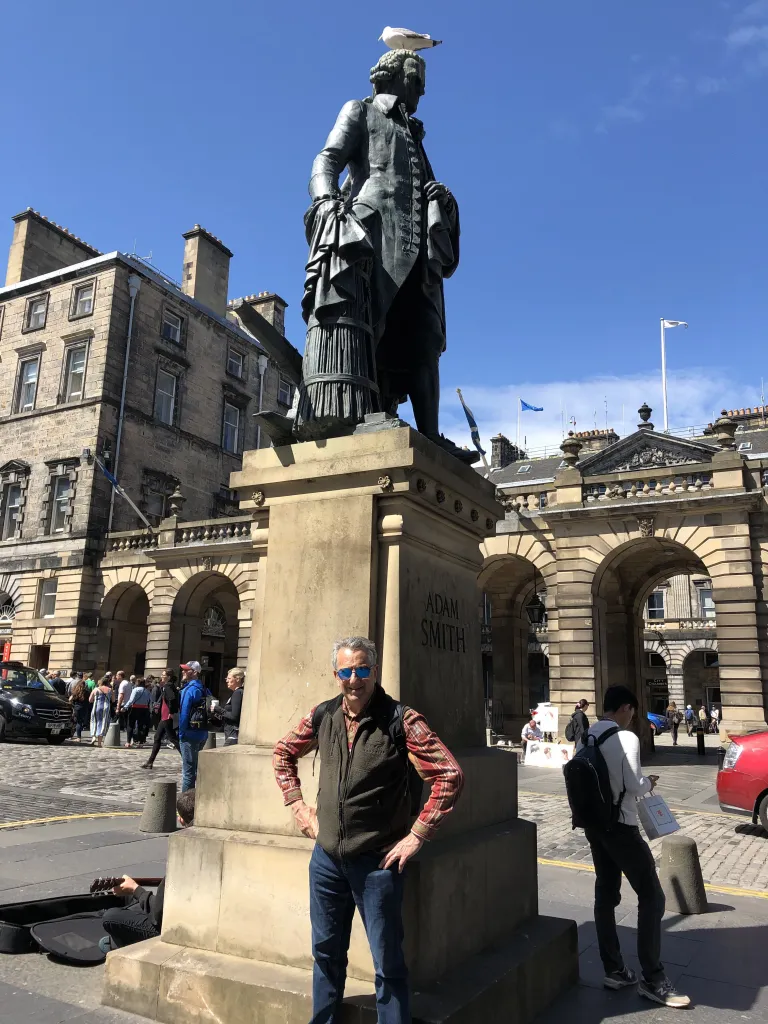
Adam Smith’s Grave
Not far from Smith’s statue, and also on Edinburgh’s Royal Mile, is the Canongate Kirkyard, where Smith lies in a quiet, fenced-in area behind the kirk (church). The modest monument states, simply, “Here are deposited the remains of Adam Smith, author of the Theory of Moral Sentiments and Wealth of Nations. He was born 5th June, 1725, and died 17th July, 1790.”
Smith is best known for Wealth of Nations—the ur-document of modern economics—which, in brief, asked why some nations are wealthy when others are not. But that book was really a sequel to Smith’s The Theory of Moral Sentiments, a sweeping treatise on humanity’s interwoven drives for self-interest and sympathy for others.
A small sign, affixed to the fence around Smith’s grave, explains briefly who he was. Unfortunately, that sign is currently defaced by graffiti, scrawled by some bampot driven not by self-interest nor sympathy for others, but rather by a desire to vandalize and misinform.
Bust of Adam Smith
In Scotland, one can hardly swing a haggis over one’s head, it seems, without striking an image of Adam Smith. Adjacent is Patric Parc’s 1845 bust of Smith and the author of this article in the magnificent Kelvingrove Art Gallery and Museum in Glasgow. In this candid photo, my profile and Smith’s bear some mutual resemblance, though my garb (tartan plaid shirt and Harris tweed cap) is more Scottish than Smith’s Roman toga.
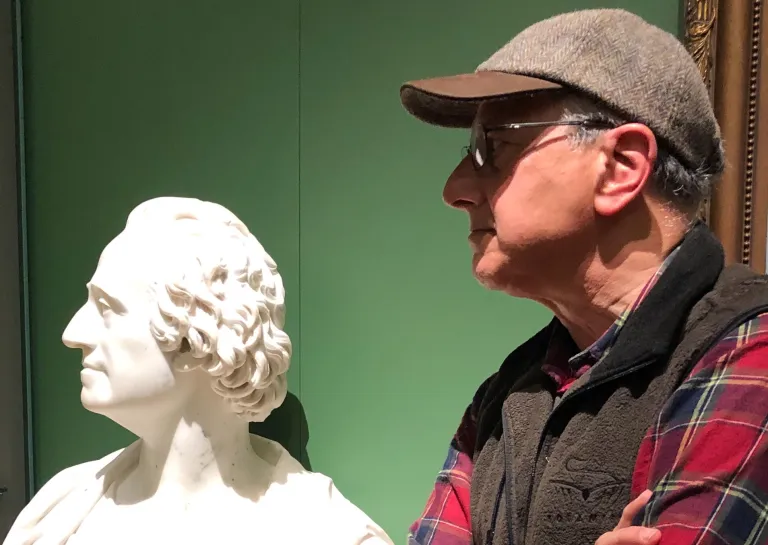
The graves of Canongate Kirkyard
As a healthcare researcher, the graves surrounding Adam Smith’s reminded me starkly how fortunate we are to live in the year 2019. Many, perhaps most, of the graves in the kirkyard show a similar pattern: the name of a husband and wife and, below their names, a list of infants and young children who died before them. Often, though not on the example pictured here, one or both spouses died at tragically early ages—often the wife, in childbirth.
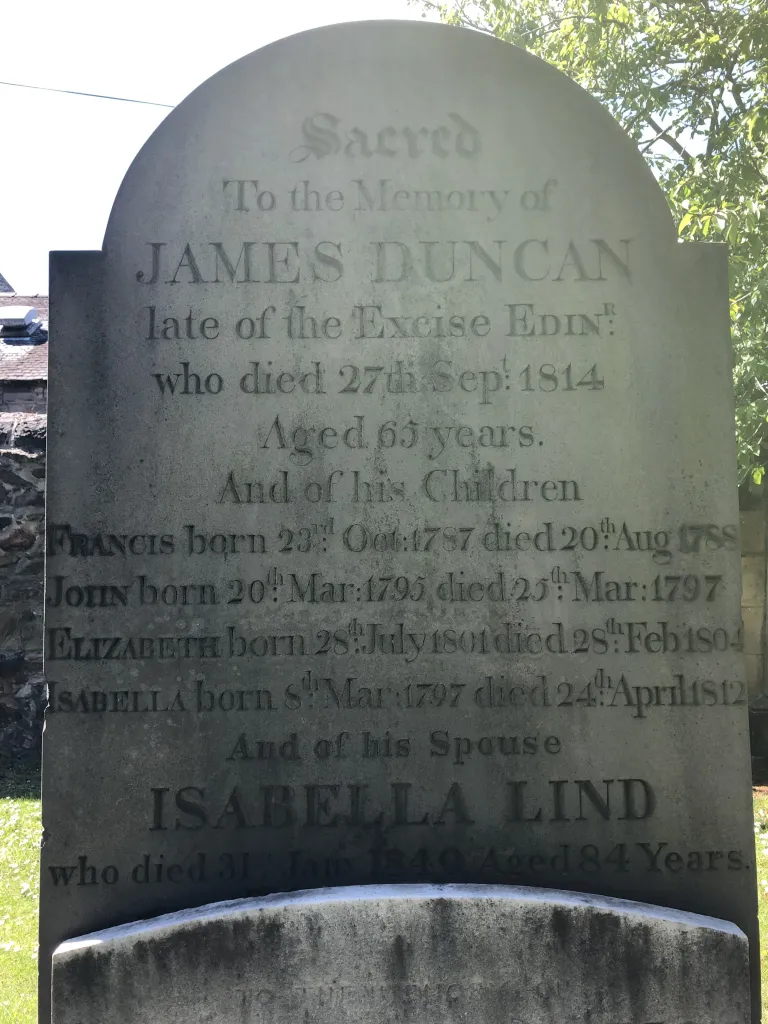
David Hume Statue
Edinburgh’s Royal Mile boasts not just one, but at least two statues of great economists. A short walk away from Smith’s statue, his friend David Hume sits grandly, in Roman garb. (To be fair, philosophers and historians have as good a claim on Hume as do economists.) Like Smith, Hume argued against the mercantilist view of international trade—a sentiment that, unfortunately, still infects political discourse, Left and Right—in 2019. Hume also argued that economic freedom is a necessary condition of political freedom, and he articulated the “is-ought problem”—the distinction between positive (objective) and normative (subjective) economics. Hume’s statue was dedicated in 1997 and, like Smith’s statue, was sculpted by Alexander Stoddart.
Missing Windows
All over Scotland, you’ll find old buildings with lots of windows, but some of them noticeably blocked up by boards or masonry. The reason lies in the Window Tax—a property tax in effect in Scotland between 1748 and 1851. One’s tax bill depended on the number of windows in the building. By covering over windows, owners of buildings could thus reduce their tax bills. Windows were often covered in a way to allow easy unblocking and reglazing at a later date, but centuries on, many of the windows remain covered. The moral of the story: “People respond to incentives.”
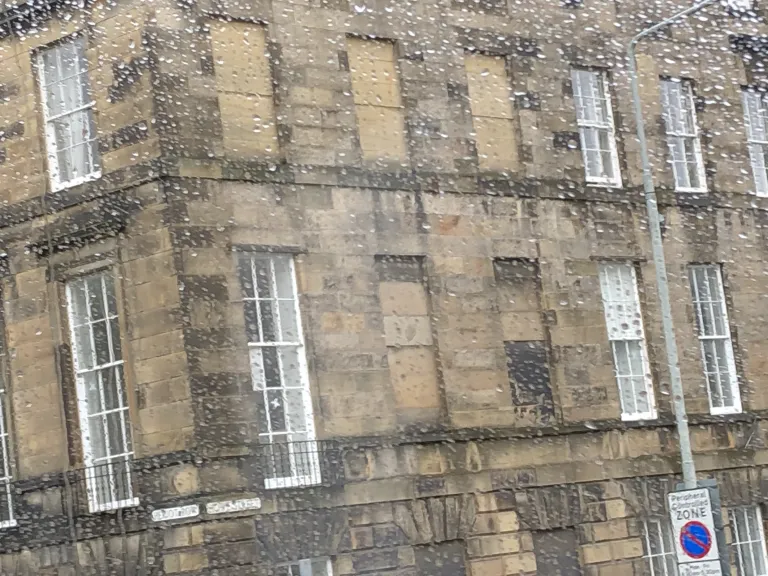
Culloden Field
The Jacobite uprising sought to restore the Stuarts to the British monarchy, thus displacing the German Hanovers, who inherited the throne in 1714. The uprising effectively ended at the grisly Battle of Culloden in 1746.
Melissa Baggley, our exceedingly bright tour guide, mentioned that afterward, the British government offered a £30,000 bounty for the capture of the Jacobite leader—Charles Edward Stuart, also known as “Bonnie Prince Charlie.” She noted that this £30,000 would, no doubt, be worth more in 2019 pounds, but she ventured no guess as to how much. The economist in me felt compelled to offer an answer, so I did some back-of-the-envelope calculations and passed them on to Melissa:
It takes roughly £200 in 2019 to buy what cost £1 in 1746. So, a bounty of £30,000 in 1746 equates to £6,000,000 in 2019. But add to this the fact that an ordinary labourer in Scotland might have earned £2.5 per year in 1746 (£500 a year in today’s money). So, the bounty on Charlie was roughly equivalent to the annual wages of 12,000 men—perhaps 300 to 500 times a worker’s lifetime earnings. With all that, no one turned in the Bonnie Prince, who escaped to a frustrated life in exile on the Continent. Either Jacobites placed an astonishingly high value on loyalty, or they were extraordinarily fearful of the terrible fate that would likely await anyone betraying their Jacobite brethren—or both.
Bonnie Prince Charlie’s escape thus recalls both Adam Smith (the drives for sympathy and self-interest) and the Window Tax (the importance of incentives).
An economic sidenote to the uprising is that Jacobite discontent stemmed to a considerable degree from the 1707 Act of Union, which fused England and Scotland into a single kingdom (Great Britain). Arguably, Scotland tumbled into that union because the country had embarked on a financially ruinous attempt to establish a colony in the Darien region of the Isthmus of Panama.
The colony was to have established an overland portage route to carry cargo from Atlantic ships to Pacific ships (and vice versa)—an antecedent to the Panama Canal, built two centuries later. Unfortunately, the Scots picked perhaps the least hospitable piece of land in the Western Hemisphere on which to establish a colony (on territory already claimed by Spain). England warned lenders not to finance the scheme, so the Scottish population, more from national pride than from investment acumen, effectively mortgaged the country’s entire economy on Darien’s success. The colony’s catastrophic failure and the financial ruin that followed forced an end to independent Scotland.
(To this day, Darién (accent mark added by the Spanish) remains a largely roadless, impassable, sometimes lawless swamp. The 100-mile Darién Gap is the only hole in the 14,000-mile Pan-American Highway, over which one can drive from Prudhoe Bay, Alaska to Ushaia, Tierra del Fuego, Argentina.)
Glasgow Royal Infirmary
One reason today’s tombstones commonly feature octogenarians and no lengthy list of deceased infants lies in theories and practices hatched at the Glasgow Royal Infirmary. There, Dr. Joseph Lister promoted sterile surgery and devised methods for cleaning wounds and sterilizing surgical instruments.
52 Queen Street, Edinburgh
It’s not open to the public, but back in Edinburgh, visitors can see the exterior of the home of James Young Simpson—another great contributor to the demise of heartbreaking tombstones. Simpson, an obstetrician, was the first to demonstrate the properties of chloroform as a general anesthetic and to promote its use in medicine. He also redesigned obstetric forceps during a time when childbirth was a major killer of women and their babies.
Alexander Fleming sculpture
I didn’t get there, but the Scottish National Portrait Gallery features a bust of Alexander Fleming, developer of penicillin—arguably the greatest single lifesaving innovation in human history.
Glasgow Green
In 1883, William Forster Lloyd wrote of the negative impact of overgrazing in common areas. In 1968, ecologist and philosopher Garrett Hardin popularized the idea with his landmark essay, “The Tragedy of the Commons.” Nobel economist Elinor Ostrom demonstrated how individuals devise arrangements for managing common resources without top-down government mandates.
Glasgow offers the real deal—Glasgow Green, established by King James II in the 1400s. It’s a public park and central location for Glaswegian civic life. For centuries, the locals were entitled to graze their livestock and do their washing on the green. Our tour guide said those entitlements still remain—though we saw no cattle, sheep, or laundry.
The Sparsely-Settled Highlands
The northerly Highlands are breathtakingly beautiful, but sparsely settled. This dates back to the Clearings—the purposeful exile of the ancient Highland communities. The British government, heavily dominated by the English, wished to use the Highlands for sheep herding—in part to supply wool to Britain’s growing textile industry and in part to satisfy the whims of arrogant central planners.
Unfortunately, cattle, an essential component of the Highland economy, are incompatible with sheep. Hence, cattle were forced out or slaughtered, depriving the locals of food and income to sustain their lives. The result was a great and sad out-migration to marginal tenant farms on the coast and to places like Canada and the United States.
The Orkneys
The Orkney Islands, just north of the British mainland, provide an excellent example of the importance of competent financial planning and counselling. In 1469, Scotland’s King James III married Margaret of Denmark—daughter of Denmark’s King Christian I. Christian was apparently poor with numbers and pledged an uncommonly generous cash dowry to accompany his daughter in marriage.
Realizing the difficulty of raising even the down payment on the dowry, he pledged the Orkneys, then a Danish possession, as collateral. After a year, still struggling to meet his debt, he added the Shetland Islands, farther north, to his collateral. Christian never managed to raise the promised funds, so Scotland took possession of both archipelagoes, and they remain Scottish to this day.
Skara Brae
Skara Brae is a remarkable set of ruins in the Orkneys. Uncovered by a fierce storm in 1850, the well-preserved ruins date back over 5,000 years—yielding fantastic knowledge about the structure of a Neolithic economy.
As guests walk from the Visitor’s Center to the ruins, the pathway is marked by a set of modern stones designed to give a sense of the great antiquity of the site. The first stones, close together mark the 1969 moon landing and the 1961 start of manned space flight. Later stones, spaced farther and farther apart show the invention of the telephone (invented, of course, by a Scotsman—Alexander Graham Bell); the First Crusade; the birth of Christ; the Great Wall Of China; the Temple of Solomon; the Pyramids of Giza; and—considerably farther out—Skara Brae.
As an American, one aspect of the walk surprised me, until I thought about it for a while. A stone at 1776 marked the American Declaration of Independence, but no stones marked the Magna Carta or the Norman Invasion. Then it hit me—the latter two are primarily English, not Scottish events, while the American Revolution was heavily influenced by the great thinkers of the Scottish Enlightenment, and a considerable portion of the American Revolutionaries were exiled Scotsmen, who were no more fond of the English rule in America than they were of English rule in Scotland.
Ring of Brodgar
Not far from Skara Brae is the Ring of Brodgar—an ancient set of enormous standing stones bearing some resemblance to England’s Stonehenge. My wife is a fan of television’s Outlander series (and I rather enjoy watching it with her), in which a much smaller set of standing stones are instrumental to the fantasy plot line. Indeed, these ancient monuments are strewn hither and yon across Scotland—standing tall and mysteriously over millennia. By the way, it appears that Outlander has produced a large uptick in Scottish tourism.
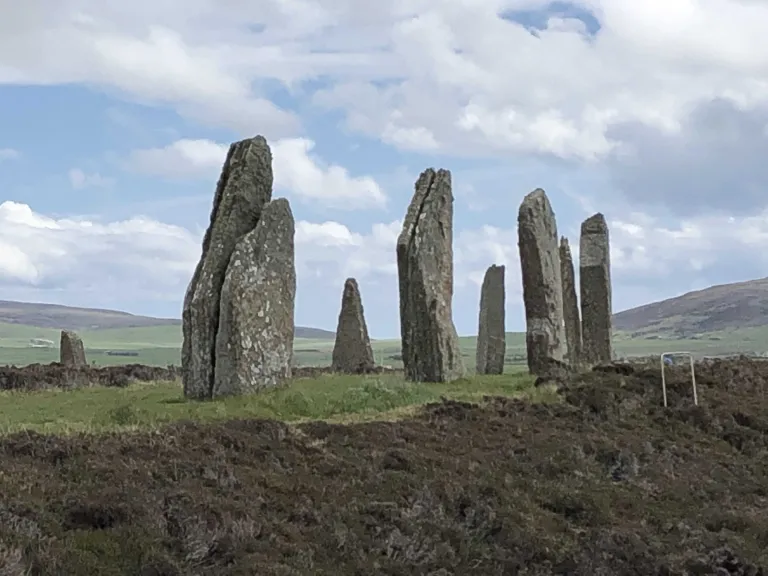
The Ring of Brodgar, near Stromness, Orkney Islands
Pennan, Arisaig, and Morar
As a devotee of the 1983 Scottish film, Local Hero, I am sorry not to have made it to the filming locations at Pennan, Arisaig, and Morar. I will mention that the film is peppered with dry economic references. My favorite is a young American oil company executive, watching a lobsterman unload a boatful of lobsters, asks whether he eats them often. “No.” he answers, “Too expensive.” The most succinct explanation of opportunity cost I’ve ever seen. The film’s plot revolves around the North Sea petroleum industry. It also mentions the rise and fall of Scotland’s historic kelp-harvesting industry and the importance of warm Gulf Stream waters to the national economy. By the way, if ever you’re feeling blue, I highly recommend Local Hero to lift your spirits.
Brexit
If you visit Scotland, prepare to get several earsful of discussion on Brexit; Scots are overwhelmingly opposed to leaving the European Union, and the controversy has ginned up the anti-English resentments that date back to long before the Act of Union.
Distilleries and Telford
Speaking of “ginned up,” Scotland has a remarkable assortment of gins and whiskies, and that industry has long played a critical role in the Scottish economy. We visited the Old Pulteney distillery, whose water system may have been designed by Thomas Telford, the great Scottish engineer who transformed the face of Great Britain and the British economy by overlaying the country with roads, bridges, canals, tunnels, and more.
St. Andrews
I told a worried golfer at St. Andrews that rain was forecast to begin just at his tee time. He wondered aloud whether Scots would still play if it were raining. I noted that golf was invented in Scotland so, given the climate, by definition Scots play in the rain.
Banknotes
For the traveler, it makes little difference, but Scotland has its own banknotes—separate from pounds issued by the Bank of England. The reasons are many, complex, and interesting. Look it up!
Slàinte mhath.
Header photo credit: Ken Jack/Getty Images; other photos by Robert and Alanna Graboyes